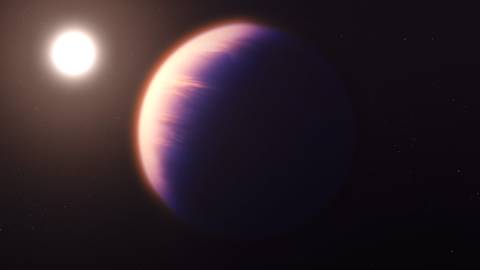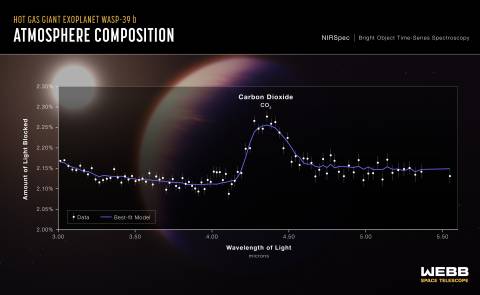Nasa’s Webb telescope makes first ever detection of carbon dioxide on alien world
Nasa’s James Webb Space Telescope has detected carbon dioxide on an alien world, for the first time. A team of more than 30 scientists analyzing the spectrum of the gas giant exoplanet Wasp 39b have reported finding a clear signal of an abundance of carbon dioxide in the planets atmosphere. Previous studies by the Hubble and Spitzer Space Telescopes had detected water vapor, potassium and sodium in the exoplanet’s atmosphere, but this is the first time carbon dioxide — a green house gas and, at least on Earth, a product of animal metabolism — has been clearly identified on distant world. The new findings have been accepted for publication in the journal Nature and are currently available on the online academic server Arxiv. The result is one of the first findings to come from Webb’s first observations, and suggests the new space telescope may also help tease apart the atmospheric components of smaller, rocky, Earth-like exoplanets during its operational life time. Accurate detection of gas concentrations in the atmospheres of such planets could help scientists detect signs of alien life, if it exists. The spectrum of Wasp 39b was one of the first five Webb images that were released to the public on 12 July, though it is not a photograph in the usual sense. Webb uses its infrared spectrometer instrument to measure the starlight passing through the atmosphere’s of distant planets like Wasp 39b, and because different elements and molecules absorb light at different wavelengths, the resulting pattern of dips and spikes reveals what chemicals are present in the intervening atmosphere. As soon as the data appeared on my screen, the whopping carbon dioxide feature grabbed me,” Johns Hopkins University graduate student Zafar Rustamkulov and member of the Webb telescope Transiting Exoplanet Community Early Release Science team said in a statement. “It was a special moment, crossing an important threshold in exoplanet sciences.” Wasp 39b is a gas giant planet orbiting a sun-like star about 700 light years from Earth. It’s roughly as massive as Saturn, but 1.3 times larger than Jupiter, a “puffiness” due to Wasp 39b’s extreme temperature; it measures around 1,600 degrees Fahrenheit, orbiting its star at a distance closer than the planet Mercury to our Sun. Accurate measurements of carbon dioxide can help scientists better understand the evolution of exoplanets such as Wasp 39b, such as how much solid versus gaseous material was involved in its formation. But the measurement also hints at the Webb telescopes capabilities to decipher the atmospheres of smaller, more Earth like rocky planets. Planets where life as we know might thrive, leaving tell-tale signs of its presence in an exoplanet’s atmosphere. Read More Sounds of black hole revealed in Nasa recorded audio How to watch the Artemis 1 launch online Nasa is about to begin going back to the Moon. Here’s when it starts
Nasa’s James Webb Space Telescope has detected carbon dioxide on an alien world, for the first time.

A team of more than 30 scientists analyzing the spectrum of the gas giant exoplanet Wasp 39b have reported finding a clear signal of an abundance of carbon dioxide in the planets atmosphere. Previous studies by the Hubble and Spitzer Space Telescopes had detected water vapor, potassium and sodium in the exoplanet’s atmosphere, but this is the first time carbon dioxide — a green house gas and, at least on Earth, a product of animal metabolism — has been clearly identified on distant world.

The new findings have been accepted for publication in the journal Nature and are currently available on the online academic server Arxiv.
The result is one of the first findings to come from Webb’s first observations, and suggests the new space telescope may also help tease apart the atmospheric components of smaller, rocky, Earth-like exoplanets during its operational life time. Accurate detection of gas concentrations in the atmospheres of such planets could help scientists detect signs of alien life, if it exists.
The spectrum of Wasp 39b was one of the first five Webb images that were released to the public on 12 July, though it is not a photograph in the usual sense. Webb uses its infrared spectrometer instrument to measure the starlight passing through the atmosphere’s of distant planets like Wasp 39b, and because different elements and molecules absorb light at different wavelengths, the resulting pattern of dips and spikes reveals what chemicals are present in the intervening atmosphere.
As soon as the data appeared on my screen, the whopping carbon dioxide feature grabbed me,” Johns Hopkins University graduate student Zafar Rustamkulov and member of the Webb telescope Transiting Exoplanet Community Early Release Science team said in a statement. “It was a special moment, crossing an important threshold in exoplanet sciences.”
Wasp 39b is a gas giant planet orbiting a sun-like star about 700 light years from Earth. It’s roughly as massive as Saturn, but 1.3 times larger than Jupiter, a “puffiness” due to Wasp 39b’s extreme temperature; it measures around 1,600 degrees Fahrenheit, orbiting its star at a distance closer than the planet Mercury to our Sun.
Accurate measurements of carbon dioxide can help scientists better understand the evolution of exoplanets such as Wasp 39b, such as how much solid versus gaseous material was involved in its formation.
But the measurement also hints at the Webb telescopes capabilities to decipher the atmospheres of smaller, more Earth like rocky planets. Planets where life as we know might thrive, leaving tell-tale signs of its presence in an exoplanet’s atmosphere.
Read More Sounds of black hole revealed in Nasa recorded audio
How to watch the Artemis 1 launch online
Nasa is about to begin going back to the Moon. Here’s when it starts


